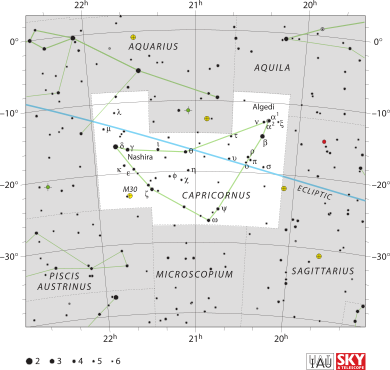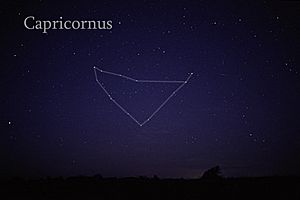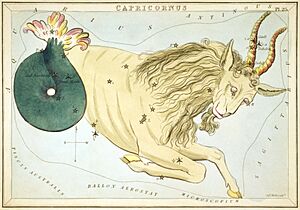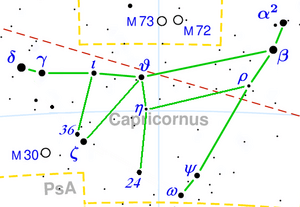Capricornus facts for kids
| Constellation | |

List of stars in Capricornus
|
|
| Abbreviation | Cap |
|---|---|
| Genitive | Capricorni |
| Pronunciation | genitive |
| Symbolism | the Sea-Goat |
| Right ascension | 20h 06m 46.4871s to 21h 59m 04.8693s |
| Declination | -8.4043999° to -27.6914144° |
| Area | 414 sq. deg. (40th) |
| Main stars | 9, 13, 23 |
| Bayer/Flamsteed stars |
49 |
| Stars with planets | 5 |
| Stars brighter than 3.00m | 1 |
| Stars within 10.00 pc (32.62 ly) | 3 |
| Brightest star | δ Cap (Deneb Algedi) (2.85m) |
| Messier objects | 1 |
| Meteor showers | Alpha Capricornids Chi Capricornids Sigma Capricornids Tau Capricornids Capricornids-Sagittariids |
| Bordering constellations |
Aquarius Aquila Sagittarius Microscopium Piscis Austrinus |
| Visible at latitudes between +60° and −90°. Best visible at 21:00 (9 p.m.) during the month of September. |
|
Capricornus is one of the constellations in the zodiac. Its name comes from Latin and means "horned goat". It is often shown as a sea goat, which is a mythical creature that is half goat and half fish.
Capricornus is one of the 88 modern constellations we know today. It was also one of the 48 constellations listed by the ancient astronomer Claudius Ptolemy almost 2,000 years ago. Its old symbol is ![]() (♑︎). This constellation is next to Aquila, Sagittarius, Microscopium, Piscis Austrinus, and Aquarius. Capricornus is found in a part of the sky called the Sea or the Water. This area has many constellations linked to water, like Aquarius and Pisces. Capricornus is the smallest constellation in the zodiac.
(♑︎). This constellation is next to Aquila, Sagittarius, Microscopium, Piscis Austrinus, and Aquarius. Capricornus is found in a part of the sky called the Sea or the Water. This area has many constellations linked to water, like Aquarius and Pisces. Capricornus is the smallest constellation in the zodiac.
Contents
Stars in Capricornus
Capricornus is not a very bright constellation. It has only one star brighter than magnitude 3.
Brightest Stars
The brightest star in Capricornus is δ Capricorni, also known as Deneb Algedi. It shines with a magnitude of 2.9. This star is about 39 light-years away from Earth. Like other stars named Deneb, its name comes from the Arabic word for "tail." So, Deneb Algedi means "the tail of the goat." Deneb Algedi is a special type of double star called an eclipsing binary. This means two stars orbit each other, and one star passes in front of the other, making the light we see change slightly.
Other bright stars in Capricornus range from magnitude 3.1 to 5.1.
- α Capricorni is actually a multiple star system. The main star, α2 Cap, is a yellow giant star about 109 light-years away. The second star, α1 Cap, is a yellow supergiant about 690 light-years away. You can see these two stars with your bare eyes! Both of them are also multiple stars themselves. The traditional names for α Capricorni, Algedi or Giedi, come from an Arabic word meaning "the kid," referring to the constellation's goat mythology.
- β Capricorni is another double star called Dabih. It is a yellow giant star about 340 light-years from Earth. Its partner is a blue-white star. You can see these two stars clearly with binoculars. The name Dabih comes from an Arabic phrase about "the lucky stars of the slaughterer."
- γ Capricorni is sometimes called Nashira, meaning "bringing good tidings." It is a white giant star about 139 light-years away.
- π Capricorni is a double star with a blue-white main star and a white partner. It is about 670 light-years away. You can see its two parts with a small telescope.
Deep-Sky Objects

Capricornus also contains several interesting objects far beyond our solar system, like star clusters and galaxies.
Messier 30
Messier 30 (also called NGC 7099) is a globular cluster. This is a huge, round group of thousands of stars, all held together by gravity. Messier 30 looks like a bright ball of stars and is about 30,000 light-years away. Even with small telescopes, you can see chains of stars stretching out from its center.
Galaxy Group HCG 87
Capricornus is home to a galaxy group called HCG 87. This group has at least three galaxies located about 400 million light-years from Earth. It includes a large elliptical galaxy and two spiral galaxies. One of the spiral galaxies is forming new stars very quickly. This suggests it is interacting (or bumping into) other galaxies in the group. The large elliptical galaxy and one spiral galaxy are even connected by a stream of stars and dust. This shows they are also interacting. Scientists think these three galaxies might merge in the future to form one giant elliptical galaxy.
History and Mythology
The constellation Capricornus has a very old history. It was first drawn on a cylinder seal around 2100 BCE. It was also clearly written about in ancient Babylonian star catalogues before 1000 BCE.
Long ago, during the Bronze Age, the winter solstice (the shortest day of the year in the northern hemisphere) happened when the Sun was in the constellation Capricornus. But because of something called the precession of the equinoxes, the December solstice now happens when the Sun is in the constellation Sagittarius. Today, the Sun appears in the constellation Capricornus from late January through mid-February.
Even though the Sun isn't in the constellation Capricornus during the winter solstice anymore, the astrological sign called Capricorn still marks this time. Also, the line on Earth where the Sun is directly overhead at noon on the December solstice is still called the Tropic of Capricorn.
Discovery of Neptune
The planet Neptune was discovered near the star Deneb Algedi (δ Capricorni) on September 23, 1846. It was found by a German astronomer named Johann Galle. At that time, Capricornus could be seen best from Europe in September.
Ancient Stories
Even though Capricornus is faint, it has one of the oldest stories linked to it. People have seen it as a mix of a goat and a fish since the Middle Bronze Age. The ancient Babylonians called it "The Goat-Fish" and linked it to their god Ea.
In Greek mythology, Capricornus is sometimes said to be Amalthea. She was a goat who nursed the baby Zeus when his mother, Rhea, saved him from his father, Cronos. Amalthea's broken horn was turned into the cornucopia, or "horn of plenty."
Capricornus is also sometimes thought to be Pan. He was a god with a goat's horns and legs. Pan saved himself from the monster Typhon by turning his lower body into a fish's tail and jumping into a river.
How to See Capricornus
The brighter stars of Capricornus form a triangle. The points of this triangle are the stars α2 Capricorni (Giedi), δ Capricorni (Deneb Algiedi), and ω Capricorni. People usually draw Capricornus as a goat with a fish's tail.
The astronomer H. A. Rey suggested a different way to connect the stars to make it look more like a goat. In his drawing:
- The goat's head is made by the stars ι Cap, θ Cap, and ζ Cap.
- The goat's horn sticks out with stars γ Cap and δ Cap.
- The goat's tail is formed by stars β Cap and α2 Cap.
- The goat's back leg is made by stars ψ Cap and ω Cap.
See also
 In Spanish: Capricornio (constelación) para niños
In Spanish: Capricornio (constelación) para niños
- Capricornus in Chinese astronomy
- Hippocampus (mythology), the mythological sea horse




